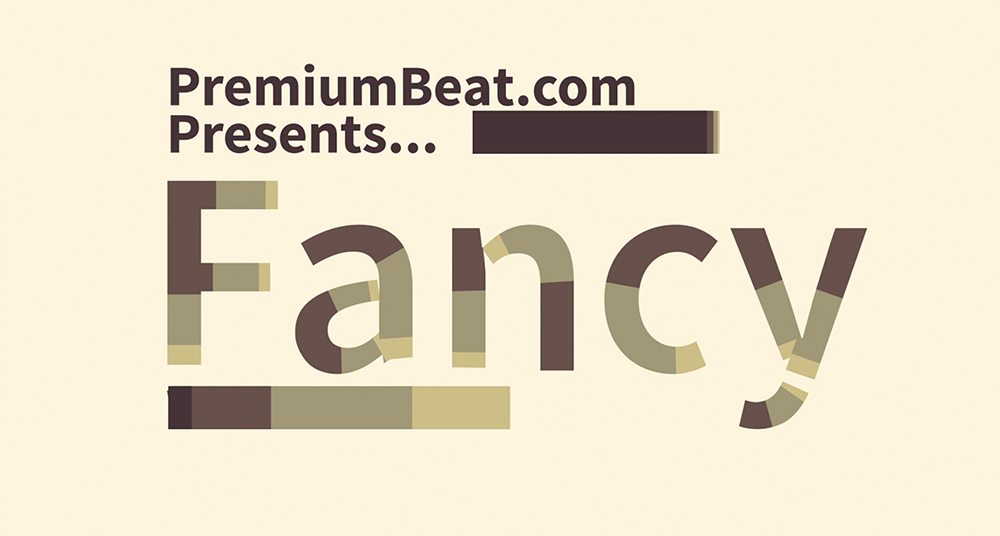
After Effects Video Tutorial: Fancy Write On Effect
Use this sleek and modern text animation to make your video intros more dynamic!

In the following video tutorial I’ll show you a trick for creating a text reveal in After Effects that’s totally in vogue right now. Whether you’re creating a motion infographic or simply need a clean, yet dynamic title for your video project, this AE write on effect will do the trick.
We’ll create this text animation using only tools within After Effects (no third party plugins). Essentially, each letter is revealed through several layers of colors (in the tutorial we used multiple shades of the same color but you can certainly experiment with different color palates).

In this After Effects text write-on tutorial we’ll:
- Create text using AE’s default text tool
- Precomp the text layer
- Use the pen tool to create shapes in the form of the letters
- Add trim paths to shapes to give motion
- Change the mode to “stencil alpha’ to only show the letters (not the shapes) animating on
Now give each of the letters a modern, multicolor write on:
- Offset the layers for each letter
- Duplicate the shape layers and make subtle changes to the fill color
The text effect takes a bit of legwork (drawing each of the shape layers) but when finished it’s a great look – clean and modern.
[color-box color=”gray”]Video Transcript:
This is Evan Abrams for premiumbeat.com, and today we’re going to take a look at creating a fancy, multicolored, multi-layered write-on effect that takes your write-on effect to the next level when bringing on text and other elements. It’s quite simple to do, it just takes a number of layers. We offset them in time, so let’s get to it.
The first thing to do in After Effects is to create a new composition as the size of whatever you’re going to be exporting. We’re using HDTV 1080, 24 frames a second, with a duration of 30 seconds. Now we’re going to be using a lot of pre-comps here, but on this comp we’re going to go ahead and create a new text layer. This will serve to have our text on it. It’s important at this stage to align your text and to kern your text as you’d like it to appear. What we’ll be doing is making use of the character palette over here to alter the size, perhaps up to 300. We’ll alter the spacing, change it from perhaps metric to optical. That looks good for me. For our purposes we’re just going to use the word “text”. I’m going to use the Align panel, window-align. You’re going to pull that up somewhere, and just stick it dead center of the composition.
We’ll be using the text here to write it on. The first thing to do is to pre-compose this text element. We go Control-Shift-C to pre-comp it. We’re going to call this “write on”. That way, if we go and put other elements around the write-on, it’s not going to interfere with what we’re doing. We go inside and we have text here. I’m going to rename this to be the stencil. I’m going to duplicate it, and call the duplication of it “guide”. The guide we’re going to change to have a nice, bright red color to it. The stencil we don’t need to look at at this point.
What we’ll be doing with the text here is using the pen tool to draw shapes over top of the letters. I’ll just go ahead and begin clicking. As you can see, it creates a shape layer that has a path on it, and then we can do things like key-framing the path and the size and the stroke. What we’re going to do is set the color to be white. We’re putting white over red, and we’re going to toggle off the transparency grid so that we are looking at these colors. We’re going to see very clearly when things are covered, when they are not covered, and so on.
We want to try to get this to be as accurate as possible. You don’t want it to be spilling too much over into other shapes, because what we’re doing with this first shape is we just want to cover up the top bar of the T. That looks about good. Then, selecting the same layer, take the pen tool and then draw the next part of that shape. A nice vertical bar like so. Move it over a little bit, and then increase its stroke size to fill that up. We’re going to rename this to be the “T” layer, and we’re going to put it below the stencil layer.
Then we are going to go in here and add trim paths. That trim paths will determine how long those lines are. We’ll just key-frame the end at the beginning to be zero percent. Move ahead thirty frames, crank it up to 100 percent. Take both of those key frames, easy ease them. Go into their graph editor here, take the handles, and give it a new shape by pulling the end handle towards the beginning to have an influence of 100 percent so that they come on with a different type of motion, accelerating and then decelerating out of the curve. Basically we have created something that we will reuse to create the rest of these.
The next thing to do here is to use your stencil. Change it to something like “stencil alpha”, such that the only parts of the line or anything below this layer that are going to be visible are going to be the things that fall within the bounds of that text. When we take away the guide, and then we take away the blackness and just look at the transparency grid, you can see we have the shape writing on.
We’ll continue this process by doing the rest of the letters, ensuring that our shape layers are individual to each letter. Starting the E, you’ll just take the pen and draw the line across. Then that will be it, and you can adjust down as needed and fill in the rest of the shapes. Draw the first couple here, and then we will skip the rest because watching me do this would be very boring.
When you have the outlines on the letter, you can go back to original here. You can just pull up the trim paths, copy it making sure the play head is at the beginning, and then paste it. Then you have those lines coming across. Now we just need to drag that below the stencil, and it makes perfect sense. You’ll continue this for each of the letters, making sure you animate them all fully and completely using the same timing for each. I’ll just accelerate through that right now.
All of your text is now animated with a wipe-on. We need to take this to the next level. We’re going to first cascade the wipe-on by going into the letters here and we’re going to offset them. The first one we’re going to offset by one frame; the next one will be offset by two frames; and the next one by three frames, or four frames, or whatever you’d like. So one comes on, and then the next, and then the next. That could change. You could change that for yours. This is just one way of doing it.
Now we take all of these, because we want to preserve that timing and impart it to all the other layers. Then we are going to pre-compose this. We are going to call this “text write-on shapes”, which will give us a composition. We will now apply a fill to that composition, which will then give it a new color other than white. We are going to go with perhaps something like 225, saturation of 50, and perhaps a brightness of 25. We are then going to duplicate that layer. We’re going to change the fill to be something new, perhaps with a brightness of 50. Duplicate again, go ahead and change this again, give it a brightness of maybe 75. Duplicate the layer a fourth time, and now we’ll go with a brightness of 100.
We are now going to take these layers we’ve created and we offset them by two, four and then six, getting rid of the guide on the back. Then we play through what we’ve created, and it looks quite wonderful. In order to go in and tweak this, all you have to do is go in here and edit these layers. What I would advise you to do is to make sure that collapse transformation is on for everything, and that again in these layers collapse transformation is on for everything.
So then, when you go back to your main comp here and press collapse transformations, you’re then able to scale this up as you’d like. However, one word of warning: Do note that when you collapse transformations, the stencil from this layer is going to come through onto this layer. What you may wish to do instead is to do all of your scaling in this part by taking these layers, parenting them all to that stencil, and then simply scaling up the stencil as need be. That way it will not negatively impact what’s going on outside of this comp. Then we are just going to arrange this into the center again, so when we go back to this comp everything is all good.
From there, it’s just a matter of stylizing everything and applying the techniques that you’ve learned to create the rest of the title elements, specifically horizontal bars that wash across. I’m sure you are smart enough to get that going.
This has been Evan Abrams for premiumbeat.com, showing you how to make a slightly more advanced and very fancy write-on technique that I think is very popular right now. Come to premiumbeat.com and check out our blog for all sorts of tips, tricks and tutorials in not only After Effects but a bunch of other terrific programs. And, of course, always come to Premium Beat for all of your royalty-free music and sound effects needs. There’s quite an extensive library here, so I would recommend you check it out, because no write-on technique is complete without an amount of whooshing and noise to go with it. Of course, mine didn’t have any, but that’s just because I’m a little bit lazy today. Anyway, thank you so much for watching. I’m Evan Abrams. Come to premiumbeat.com and I’ll see you around the internet.[/color-box]



